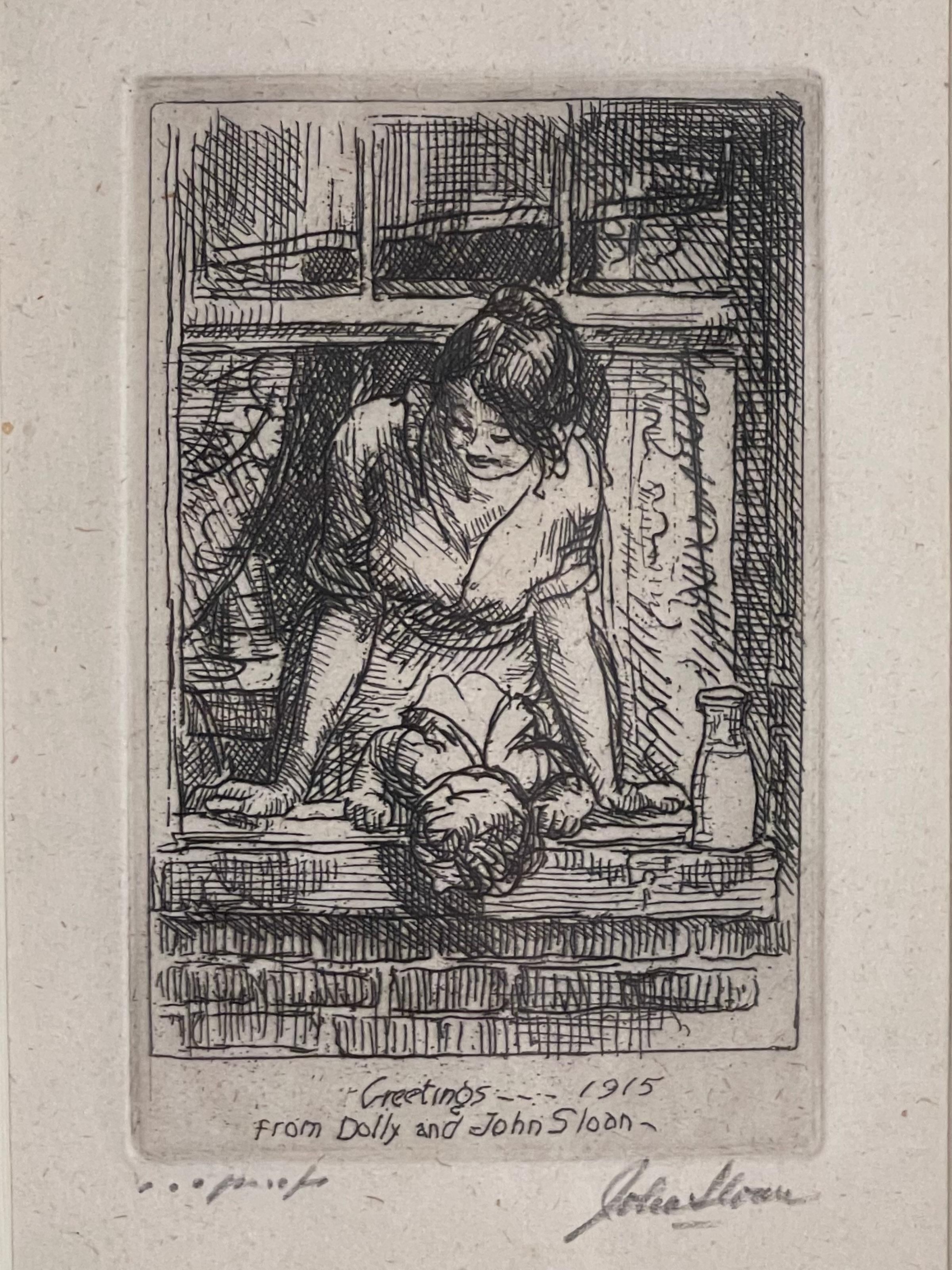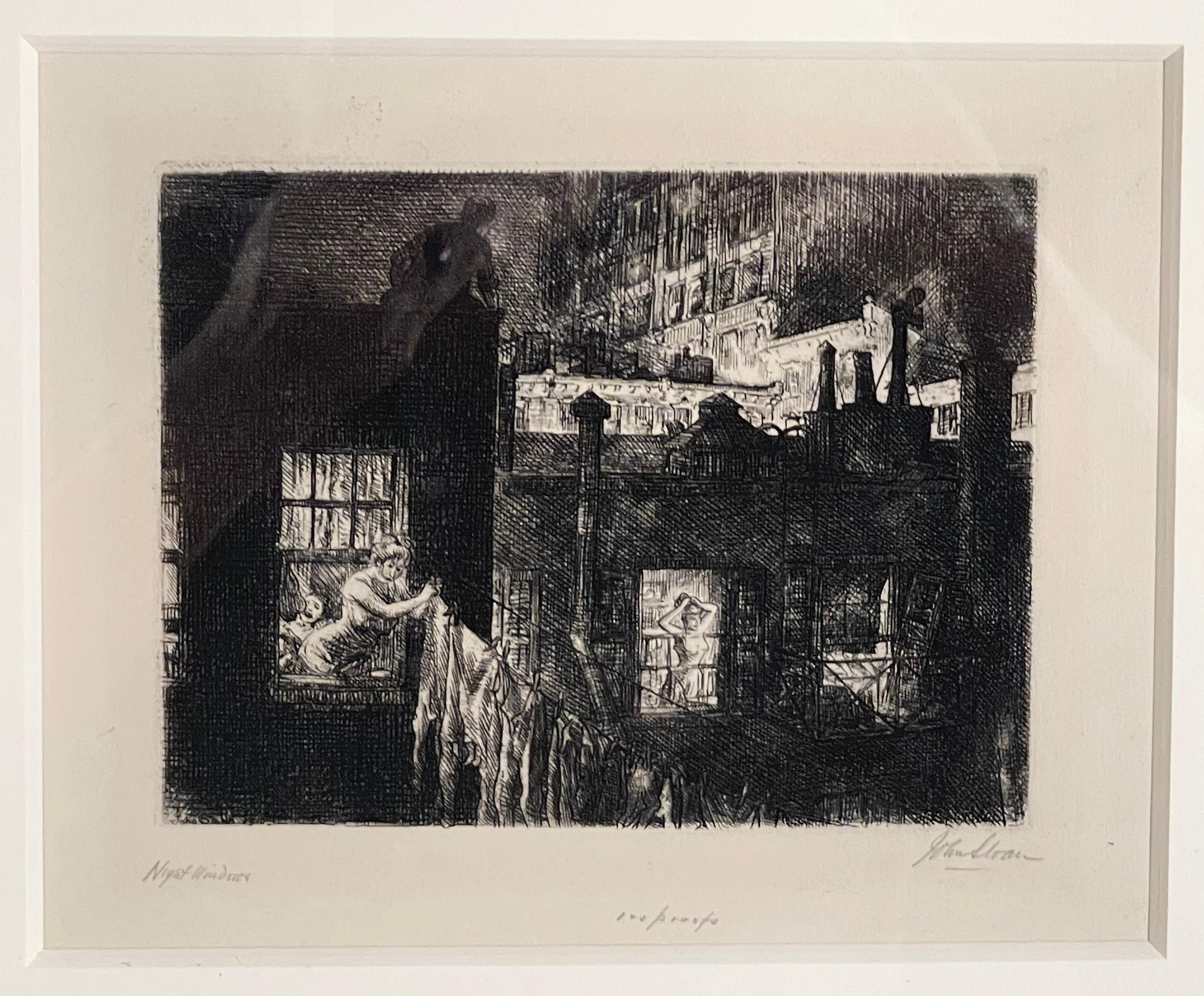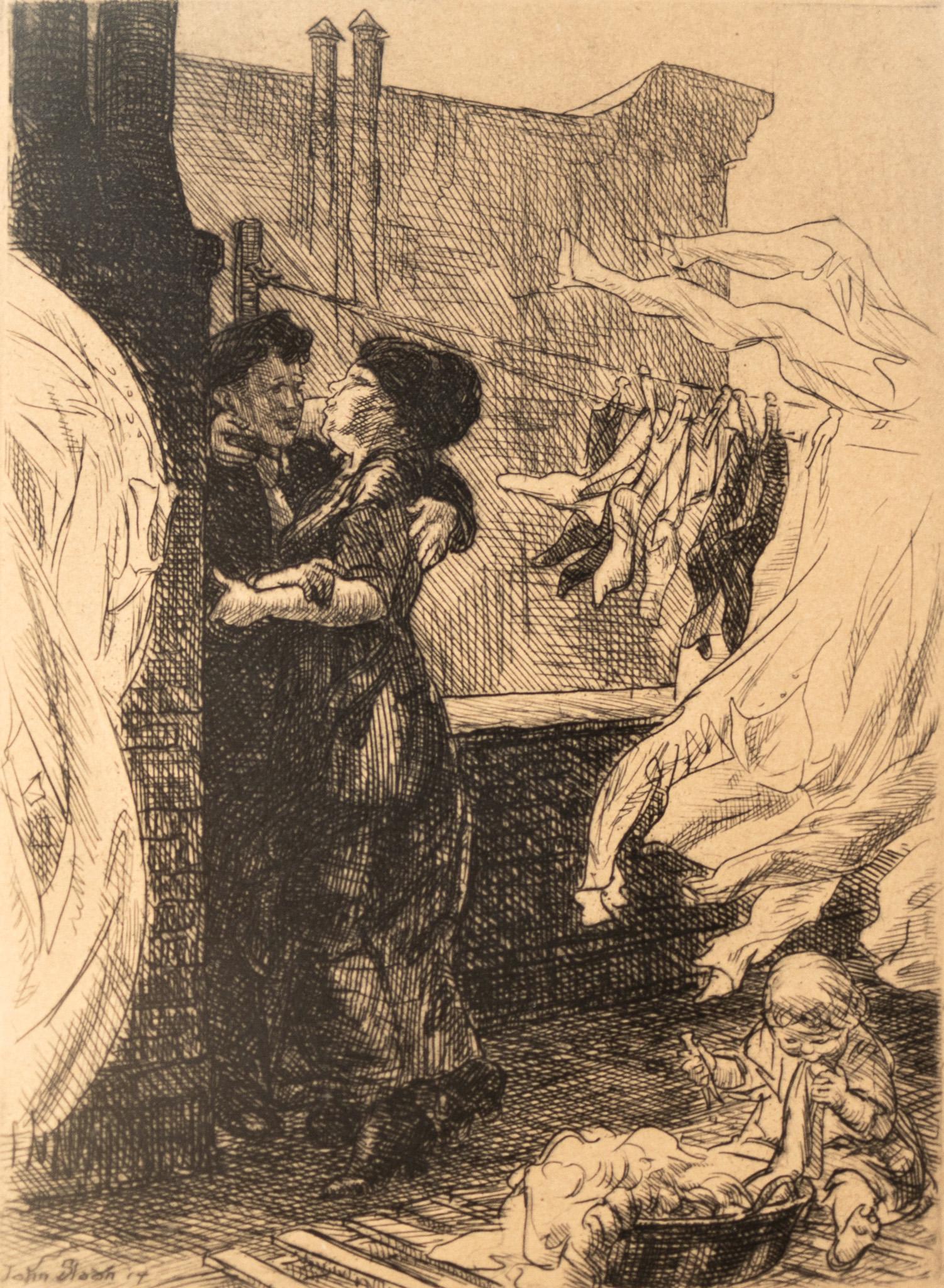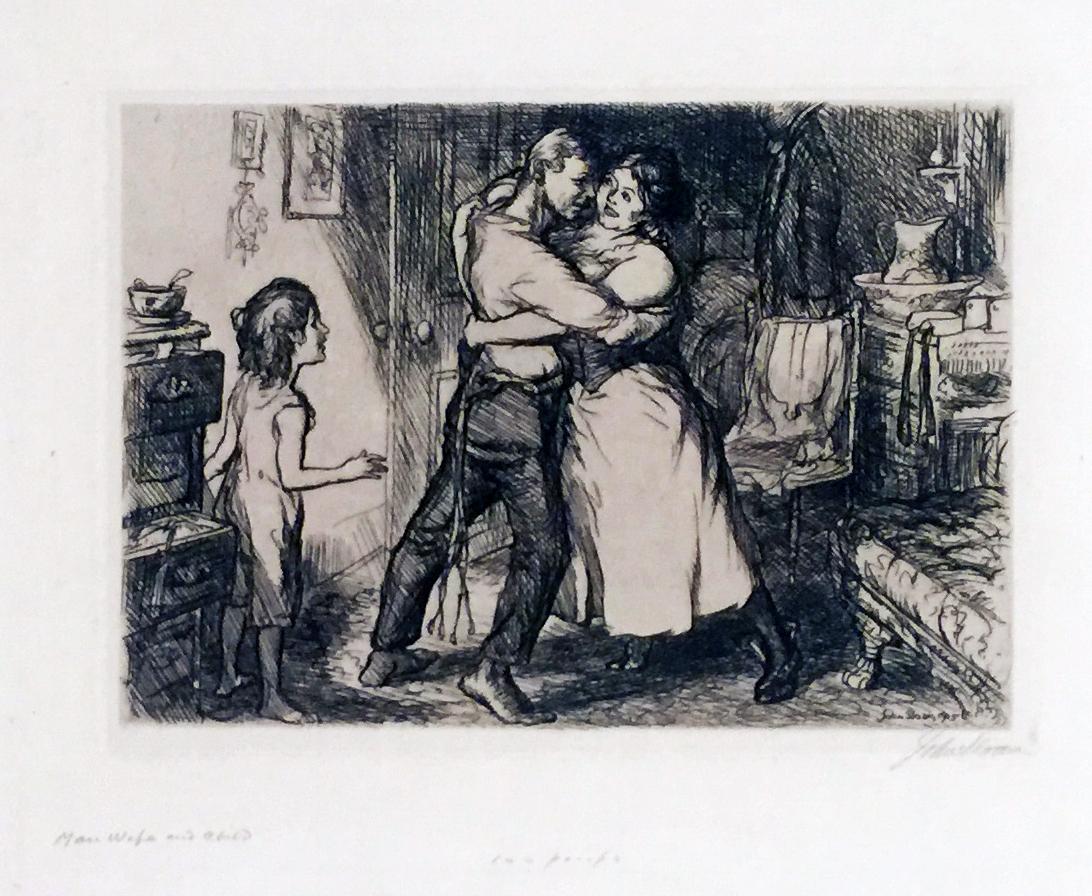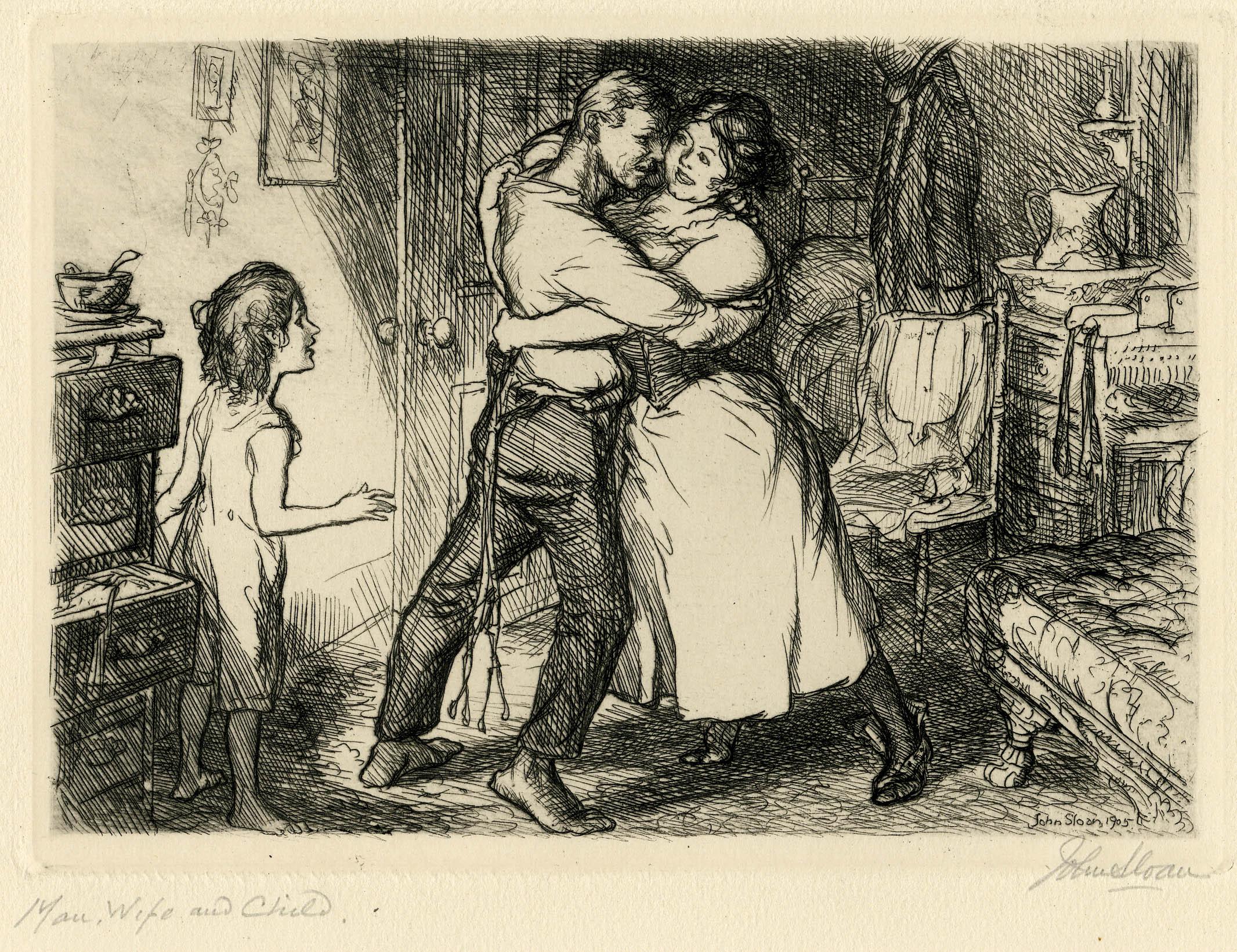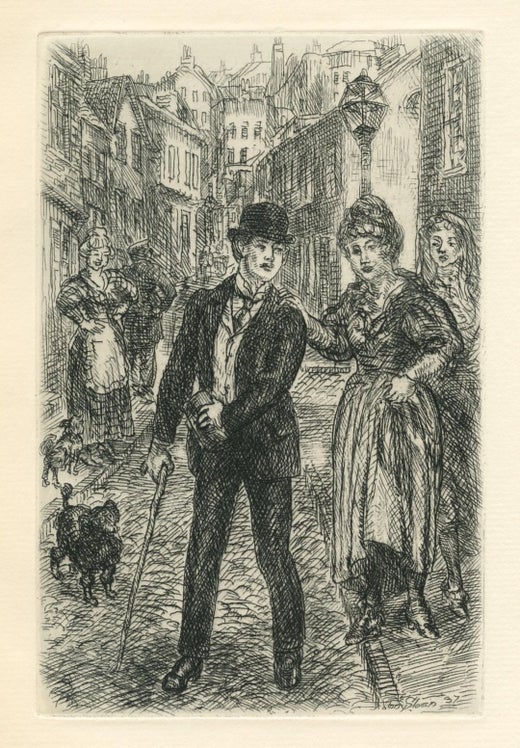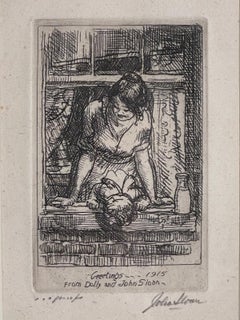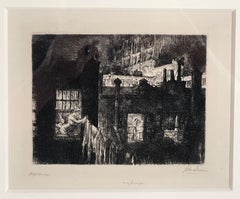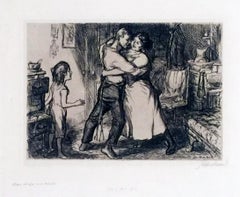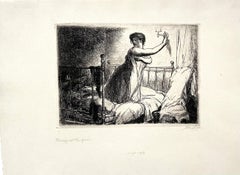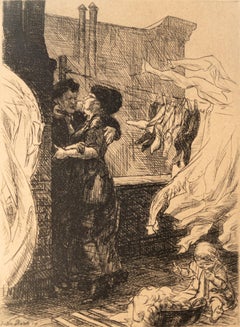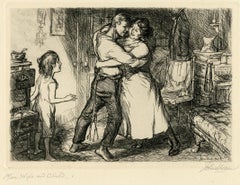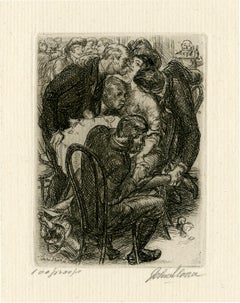Items Similar to SISTERS AT THE WINDOW
Want more images or videos?
Request additional images or videos from the seller
1 of 5
John SloanSISTERS AT THE WINDOW1923
1923
$2,500
£1,888.47
€2,182.53
CA$3,513.17
A$3,906.04
CHF 2,056.77
MX$47,392.01
NOK 26,039.67
SEK 24,340.74
DKK 16,287.34
About the Item
Sloan, John. SISTERS AT THE WINDOW. Etching, 1923 (M. 208). 5" x 4", signed and titled in pencil and inscribed "100 Proofs," of which only 76 were printed this being one of 25 early proofs, on laid paper, with tack holes for drying. Very good condition. "A girl on the brink of adolescence under the watchful eye of her younger sister, both under the watchful eye of the neighboring etcher. Subject matter which produced one of my best plates.
- Creator:John Sloan (1832-1932, American)
- Creation Year:1923
- Dimensions:Height: 20 in (50.8 cm)Width: 16 in (40.64 cm)
- Medium:
- Movement & Style:
- Period:
- Condition:
- Gallery Location:Portland, ME
- Reference Number:Seller: 23041stDibs: LU36731511763
John Sloan
John Sloancame to New York in 1904 and worked for some time as a freelance illustrator. With Robert Henri, he organized an exhibition of a group of urban realist painters, known as "The Eight" or the "Ashcan School," who challenged traditional notions of art. Having moved to the Village in 1912, Sloan lived with his wife Dolly at 240 West 4th Street and at 88 Washington Place.
About the Seller
5.0
Recognized Seller
These prestigious sellers are industry leaders and represent the highest echelon for item quality and design.
Established in 1966
1stDibs seller since 2016
351 sales on 1stDibs
Typical response time: 1 hour
Associations
International Fine Print Dealers Association
- ShippingRetrieving quote...Shipping from: Portland, ME
- Return Policy
Authenticity Guarantee
In the unlikely event there’s an issue with an item’s authenticity, contact us within 1 year for a full refund. DetailsMoney-Back Guarantee
If your item is not as described, is damaged in transit, or does not arrive, contact us within 7 days for a full refund. Details24-Hour Cancellation
You have a 24-hour grace period in which to reconsider your purchase, with no questions asked.Vetted Professional Sellers
Our world-class sellers must adhere to strict standards for service and quality, maintaining the integrity of our listings.Price-Match Guarantee
If you find that a seller listed the same item for a lower price elsewhere, we’ll match it.Trusted Global Delivery
Our best-in-class carrier network provides specialized shipping options worldwide, including custom delivery.More From This Seller
View AllGREETINGS, 1915 or MOTHER AND CHILD AT THE WINDOW
By John Sloan
Located in Portland, ME
Sloan, John. GREETINGS, 1915 or MOTHER AND CHILD AT THE WINDOW. Morse 170. Etching, 1914. Edition of 100 of which only 75 were printed. Signed in pencil and inscribed in pencil "Gree...
Category
1910s Figurative Prints
Materials
Etching
NIGHT WINDOWS
By John Sloan
Located in Portland, ME
Sloan, John (American, 1871-1951). NIGHT WINDOWS. Morse 152. Etching and drypoint, 1910. The 5th state of 5. Edition of 100. Titled, signed, and inscribed...
Category
1910s Figurative Prints
Materials
Drypoint, Etching
MAN, WIFE, AND CHILD
By John Sloan
Located in Portland, ME
Sloan, John. MAN, WIFE AND CHILD. Morse 135. Etching, 1905. Titled,
signed, and inscribed "100 proofs," all in pencil. 5 x 7 inches
(plate), 10 x 12 3/4 inches (sheet). Printed on w...
Category
Early 1900s Figurative Prints
Materials
Etching
TURNING OUT THE LIGHT
By John Sloan
Located in Portland, ME
Sloan, John. TURNING OUT THE LIGHT. M. 134. Etching, 1905. 5 x 7 inches; 127 x 178 mm. (plate), 9 1/2 x 11 1/2 (sheet). Titled, inscribed "100 Proofs" and signed, all in pencil. Whi...
Category
Early 1900s Figurative Prints
Materials
Etching
SHINE, WASHINGTON SQUARE
By John Sloan
Located in Portland, ME
Sloan, John. SHINE, WASHINGTON SQUARE. Morse 206. Etching, 1923. Signed, titled and inscribed "100 proofs," and further inscribed "Peter Platt imp."
Morse says that 80 were print...
Category
1920s Ashcan School Figurative Prints
Materials
Etching
FRANKIE AND JOHNNIE or HIM
By John Sloan
Located in Portland, ME
Sloan, John (American, 1871-1951). FRANKIE AND JOHNNIE. or HIM Morse 236. Etching, 1928. Edition of 100 (but only 50 were printed, by Platt). Dated and Titled in the plate, and Signed in pencil by Sloan and inscribed "100 Proofs," and also signed by Peter Platt. With tack holes and deckled edges. 5 x 8 inches, 126 x 203 mm. (plate), 8 1/2 x 12 1/4 inches (sheet). In excellent condition.
From Morse:
" A small chorus singing 'Frankie and Johnnie' crowds the tiny stage of the Provincetown Players Theater in MacDougal Street. An episode from E. E. Cummings' intelligent and entertaining production, HIM." (Sloan writing in 1945).
"HIM" is about as thrilling an evening's entertainment as I have ever experienced. I liked it thoroughly -- I do not claim to understand it -- I do not believe that a work of art can be, nor need be understood, even by the maker. It seemed to me to be a glimpse inside the cranium of an artist-poet." (Sloan in a letter to James Light, the director of the play)
Though Morse says the stars were Hemsley Williams and Goldye Steiner, it was actually Hemliey Winfield (1907 - 1934), the founder of the New Negro Art Theater Dance Group. This company was very successful and highly regarded. It appeared in the Metropolitan Opera's premier of Louis Gruenberg's setting of Eugene O'Neill's "The Emperor...
Category
1920s Figurative Prints
Materials
Etching
You May Also Like
"Love on the Roof" American Realist Etching
By John Sloan
Located in Austin, TX
By John Sloan
American Realist
From the early 20th century Ashcan School which focused on capturing day to day life in New York City during that period.
Image size: 5.75" x 4.25"
Et...
Category
Early 20th Century American Realist Figurative Prints
Materials
Archival Paper, Etching
Man, Wife and Child
By John French Sloan
Located in Fairlawn, OH
Man, Wife and Child
Etching, 1905
Signed and titled in pencil by the artist below image (see photo)
Annotated in pencil by the artist "100 proofs"
Signed and dated in the plate lower...
Category
Early 1900s Ashcan School Figurative Prints
Materials
Etching
The Green Hour (or Angna Enters in “The Green Hour”)
By John Sloan
Located in New York, NY
John Sloan (1871-1954), The Green Hour (or Angna Enters in “The Green Hour”), etching, 1930, signed in pencil lower right, inscribed “100 proofs” lower le...
Category
1930s American Realist Portrait Prints
Materials
Etching
New Year’s Eve and Adam
By John Sloan
Located in Myrtle Beach, SC
John Sloan, 'New Year's Eve and Adam', etching, 1918, edition 100, (only 85 printed), Morse 190. Signed, titled and annotated '100 proofs' in pencil. Signed and dated in the plate, l...
Category
1910s Ashcan School Figurative Prints
Materials
Etching
Up the Line, Miss?
By John Sloan
Located in New York, NY
John Sloan (1871-1951), “Up the Line, Miss?”, etching, 1930, signed, titled and inscribed 100 proofs [also signed in the plate]. Reference: Morse 243, fifth state (of 5). In excellen...
Category
1930s American Realist Figurative Prints
Materials
Etching
Nude at Dressing Table
By John Sloan
Located in Middletown, NY
Sloan was so fond of this composition that he made a painting after the etching ten years after its completion, in 1943. Completed in Santa Fe, the painting is now housed in the perm...
Category
1930s American Modern Nude Prints
Materials
Etching
More Ways To Browse
Painting Antique Windows
Girls In Windows
Girls In The Window
Antique Etched Windows
John Sloan Etchings
19th Century Russian Portrait
Benjamin Long
Black Woman In Red Dress Painting
Oil Priests
Bengali Art
Folk Art Painting Thomas
Greek Mythology Oil Painting
Portrait Esther
Rabbi Oil
Church Gate
Faure Artist
Holland And Holland Watch
Red Haired Woman Oil Painting
